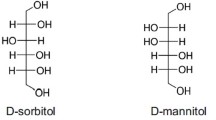Summary
-
1.
Experiments on female Wistar albino rats, given intraperitoneal injections of intensely hypertonic NaCl solutions, revealed a rather specific stimulation of the glomerulosa layer. This change is noteworthy because previous observations had shown that diets rich in sodium cause atrophy of this same layer, while sodium-deficient diets stimulate it. Thus, somewhat paradoxically, acute NaCl intoxication shares with chronic sodium deficiency the ability of stimulating the glomerulosa of the adrenal cortex.
-
2.
Chronic overdosage with stilbestrol tends to cause involution of the glomerulosa and prevents its stimulation by acute NaCl overdosage.
-
3.
These observations furnish further evidence in support of the view that certain stimuli can cause qualitatively distinct adrenocortical responses, which cannot be explained merely by an increased ACTH production.
-
4.
Intraperitoneal administration of hypertonic NaCl, urea or glucose solutions cause certain cytolytic phenomena in the adrenal medulla, which result in the formation of “pseudo-acinar” structures, reminiscent of the “struma suprarenalis cystica” of human pathology.
-
5.
All three of these hypertonic solutions are also conducive to the appearance, within the lumina of the cortical sinusoids, of minute basophilic granules which appear to aggregate into larger clumps and eventually form voluminous grape-like aggregates of basophilic material, by the time they reach the medullary sinuses. The functional significance of this basophilic material is not clear, but it may represent a secretory product or a by-product of activity in the adrenals.
Zusammenïassung
-
1.
Versuche an weiblichen Wistar-Albino-Ratten, welchen stark hypertonische NaCl-Lösungen intraperitoneal injiziert worden waren, zeitigten eine ziemlich spezifische Reizung der Zona glomerulosa. Diese Veränderung ist bemerkenswert, weil frühere Beobachtungen gezeigt hatten, daß natriumreiche Kost eine Atrophie ebendieser Schicht verursacht, während natriumfreie Kost sie anregt. Daher haben — eine etwas paradoxe Erscheinung — akute NaCl-Vergiftungen und chronischer Natriummangel die Fähigkeit gemein, die Zona glomerulosa der Nebennierenrinde zu reizen.
-
2.
Chronische Überdosierung von Stilbestrol bewirkt eine Involution der Glomerulosa und verhindert ihre Reizung durch akute NaCl-Überdosierung.
-
3.
Diese Beobachtungen liefern ein weiteres Argument zur Stützung der Ansicht, daß gewisse Reize qualitativ deutliche adrenokortikale Reaktionen verursachen können, die man nicht bloß durch eine gesteigerte ACTH-Produktion erklären kann.
-
4.
Intraperitoneale Gaben von hypertonischem NaCl, Harnstoff- oder Glukoselösungen verursachen bestimmte cytolytische Erscheinungen im Nebennierenmark, welche zur Bildung “pseudo-acinöser” Strukturen führen, die an die “Struma suprarenalis cystica” der Humanpathologie erinnern.
-
5.
Alle drei dieser hypertonischen Lösungen fördern auch — und zwar innerhalb der Lumina der kortikalen Sinusoide — das Auftreten kleinster basophiler Granula, die sich zu größeren Klumpen vereinigen und voluminöse traubenartige Ansammlungen von basophilem Material bilden, die schließlich auch in dem medullären Sinus zu sehen sind. Die funktionelle Bedeutung dieses basophilen Materials ist unklar, doch kann es ein Sekretionsprodukt oder ein Nebenprodukt der Nebennierentätigkeit bilden.
Résumé
-
1.
Des expériences sur des rats albinos Wistar auxquels on avait injecté intrapéritonéalement des solutions de NaCl intensément hypertoniques révélaient une stimulation assez spécifique de la couche gloméruleuse. Ce changement est remarquable parce que des observations antérieures avaient montré que la nourriture riche en sodium cause une atrophie de cette couche tandis qu'une nourriture sans sodium la stimule. Ainsi, quelque peu paradoxalement, l'intoxication aiguë avec du NaCl et la déficience chronique en sodium ont en commun la capacité de stiumler la couche gloméruleuse de l'écorce surrénale.
-
2.
Le surdosage chronique de stilbestrol cause une involution de la couche gloméruleuse et empêche sa stimulation par un surdosage aigu de NaCl.
-
3.
Ces observations fournissent plus d'evidence à l'avis que certains stimuli peuvent causer des réponses adrénocorticales qualitativement distinctes que l'on ne peut expliquer que par une production augmentée de ACTH.
-
4.
L'administration intrapéritonéale de NaCl hypertonique, de solutions d'urée ou de glucose cause certains phénomènes dans la moelle surrénale qui mènent à la formation de structures «pseudo-acineuses» qui nous rappellent la «struma suprarenalis cystica» de la pathologie humaine.
-
5.
Toutes les trois solutions hypertoniques avancent aussi, l'apparence de très petites granules basophiles dans des lumina des sinusoïdes corticaux, qui semble s'associer à des masses plus grandes et qui enfin forment des agrégats à l'air de grappes volumineuses de matériel basophile qui finalement sont aussi à voir dans les sinus médullaires. La signification fonctionelle de ce matériel basophile n'est pas clair mais représente peut être un produit sécrétoire ou un produit secondaire de l'activité surrénales.
Similar content being viewed by others
Literature cited
Deane, H. W., J. H. Shaw andR. O. Greep, The effect of altered sodium or potassium intake on the width and cytochemistry of the zona glomerulosa of the rat's adrenal cortex. Endocrinology (Am.)43 (1948), 133–153.
Dietrich, A., undH. Siegmund, Die Nebenniere und das chromaffine System. Verlag Julius Springer, Berlin, 1926.
Ponse, K., L'histophysiologie thyroïdienne. Ann. d'endocrinol.12 (1951), 266–317.
Ponse, K., andH. Altschuler, Histophysiologie de l'activation thyroïdienne. Arch. Anat. etc. (Fr.)29 (1938), 1–253. —Selye, H., Stress
The physiology and pathology of exposure to systemic stress. Acta Inc., Publ., Montreal, 1950.
Selye, H., First Annual Report on Stress. Acta Inc., Publ., Montreal, 1951.
Selye, H., andH. Stone, On the experimental morphology of the adrenal cortex (correlation with clinical pathology). American Lecture Series, 1950.
Author information
Authors and Affiliations
Additional information
With 11 fugures.
Rights and permissions
About this article
Cite this article
Selye, H. Adrenal changes produced by the parenteral administration of highly hypertonic solutions. Acta Neurovegetativa 6, 212–219 (1953). https://doi.org/10.1007/BF01227351
Issue Date:
DOI: https://doi.org/10.1007/BF01227351




